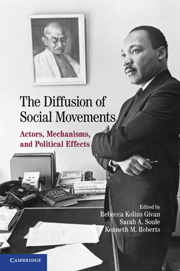Book contents
- Frontmatter
- Contents
- List of Tables
- List of Figures
- Contributors
- Preface and Acknowledgments
- 1 Introduction: The Dimensions of Diffusion
- PART I DIFFUSION AND THE FRAMING OF CONTENTIOUS POLITICS
- PART II MECHANISMS OF DIFFUSION
- PART III DIFFUSION, SCALE SHIFT, AND ORGANIZATIONAL CHANGE
- General Bibliography
- Index
1 - Introduction: The Dimensions of Diffusion
Published online by Cambridge University Press: 05 June 2012
- Frontmatter
- Contents
- List of Tables
- List of Figures
- Contributors
- Preface and Acknowledgments
- 1 Introduction: The Dimensions of Diffusion
- PART I DIFFUSION AND THE FRAMING OF CONTENTIOUS POLITICS
- PART II MECHANISMS OF DIFFUSION
- PART III DIFFUSION, SCALE SHIFT, AND ORGANIZATIONAL CHANGE
- General Bibliography
- Index
Summary
The concept of diffusion is widely used by social scientists to refer to the spread of some innovation through direct or indirect channels across members of a social system (Rogers 1995). Diffusion effects are often recognized, for example, in the spread of new technologies, the adoption of policy reforms (see, e.g., Soule and Zylan 1997; Weyland 2006; Simmons et al. 2006), and changes in political regimes (Hagopian and Mainwaring 2005; Brinks and Coppedge 2006). One of the most prominent areas of research on diffusion, however, is in the field of social movements (Strang and Soule 1998; Soule 2004). Observers, participants, and scholars of “contentious politics” have long been intrigued by how social movements (or some element thereof, such as a tactic, frame, symbol, issue, or outcome) spread or diffuse from one site to another. It is commonplace in both media and scholarly accounts of social movements to remark about how some issue or form of protest has spread across a country – or, in some cases, from one country to another.
Indeed, diffusion undoubtedly helps to account for the wavelike character of protest cycles and other types of social mobilization (Tarrow 1998a). Simply put, social movements in one site (or time period) are often inspired or influenced by movements elsewhere. One cannot understand social movements – how they evolve, how they expand, how they engage the political arena – without understanding the dynamics of diffusion.
- Type
- Chapter
- Information
- The Diffusion of Social MovementsActors, Mechanisms, and Political Effects, pp. 1 - 16Publisher: Cambridge University PressPrint publication year: 2010
- 27
- Cited by

